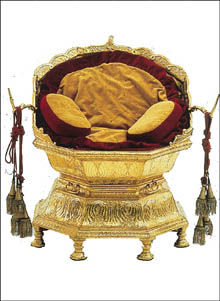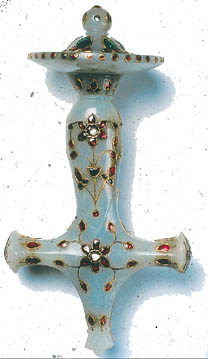




















 

 |
Showcasing Sikh art in the West
About
4,00,000 Sikhs living in the UK have already visited a
unique exhibition showcasing the artistic traditions of
Punjab under the Sikh rule. If this exhibition comes to
India in April 2000, it will be a rare feast of the
history of Punjab,
says Himmat Singh Gill.
A SHORT distance off the John F.
Kennedy Drive and 8th Avenue, in the Asian Art Museum
located in the Golden Gate Park of the city of San
Francisco in California, history is being made with the
staging of the first ever comprehensive exhibition
showcasing the artistic traditions of Punjab under the
Sikh rule. A visit to this display of textiles,
paintings, ceramics, metalwork, decorative arts and
photography was an eye-opener. It was organised by the
Victoria and Albert Museum, London, and presented in the
United States of America under the auspices of the Asian
Art Museum, and the Sikh Foundation of Palo Alto, whose
founder Narinder S. Kapany has provided enthusiastic
support in every conceivable manner. He has generously
donated over 90 works of Sikh art from his very own
personal collection to the Asian Art Museum.
 Born in Punjab and educated in England, Dr
Kapany has lived in the United States for over 40 years,
and the whole idea of this exhibition devoted to Sikh
culture has been his brainchild, whereafter negotiating
with the Victoria and Albert Museum, he has been
successful in putting on view this exhibition in the Bay
Area of San Francisco, home to a large Indian population,
predominant among it being the versatile and
large-hearted Punjabis from the land of the five rivers.
This unique show which opened on September 22, this year,
will continue till January 9, 2000, and provide an
opportunity to Indians and non-Indians alike, to
experience the cultural efflorescence of the Sikhs as an
integral part of Indian culture. Born in Punjab and educated in England, Dr
Kapany has lived in the United States for over 40 years,
and the whole idea of this exhibition devoted to Sikh
culture has been his brainchild, whereafter negotiating
with the Victoria and Albert Museum, he has been
successful in putting on view this exhibition in the Bay
Area of San Francisco, home to a large Indian population,
predominant among it being the versatile and
large-hearted Punjabis from the land of the five rivers.
This unique show which opened on September 22, this year,
will continue till January 9, 2000, and provide an
opportunity to Indians and non-Indians alike, to
experience the cultural efflorescence of the Sikhs as an
integral part of Indian culture.
A large number of
objects in the exhibition pertain to the period of the
celebrated nineteenth century Sikh monarch Maharaja
Ranjit Singh, also known as the "Lion of
Punjab". Ranjit Singh’s Golden Throne, used for
important state visits was made by a Muslim goldsmith in
Lahore. The core is made of wood, and the outside is
covered with embossed sheets of pure gold and decorated
with floral motifs. The opulence of the Emperor’s
court was legendary, making a European observer exclaim
in wonder, "It reduces European magnificence to a
very low pitch".
Another exhibit from the
Victoria and Albert Museum, is the hilt for a sword, with
white nephrite jade set with rubies emeralds and diamonds
in gold, dating back to the Mughal period in the late
17th century. A sword hilt of this kind could either have
been worn in those days by a Mughal courtier or a
prominent Sikh. Also quite astoundingly stunning is the
19th and early 20th centuries turban, worn by the
well-armed Akalis, with five large circular rings known
as quoits stacked on it, and other oval and
semi-circular, double-edged blades laid flat against it.
This exhibit from Lahore in cotton and other
embellishments of steel overlaid with gold, is an
offering of the Victoria and Albert Museum.
 This exhibition features 150 objects of
the highest quality drawn from private and public
collections in India, Pakistan, Europe and North America.
These works of art exemplify the extraordinary refinement
of Sikh cultural traditions spread over a span of three
centuries. The intricately decorated weapons and armour,
some inlaid with animal figures, and garments embroidered
with gold thread, convey the richness and the opulence of
the Sikh court. Of particular significance are the
delicately rendered paintings representing the very best
in the Hindu, Sikh and Mughal traditions, and of course
the majestic and richly decorated golden throne of
Maharaja Ranjit Singh. The inclusion of loaned works from
both India and Pakistan is an important statement on the
shared history of this region. This exhibition features 150 objects of
the highest quality drawn from private and public
collections in India, Pakistan, Europe and North America.
These works of art exemplify the extraordinary refinement
of Sikh cultural traditions spread over a span of three
centuries. The intricately decorated weapons and armour,
some inlaid with animal figures, and garments embroidered
with gold thread, convey the richness and the opulence of
the Sikh court. Of particular significance are the
delicately rendered paintings representing the very best
in the Hindu, Sikh and Mughal traditions, and of course
the majestic and richly decorated golden throne of
Maharaja Ranjit Singh. The inclusion of loaned works from
both India and Pakistan is an important statement on the
shared history of this region.
"The Arts of the
Sikh Kingdoms" marks the 300th anniversary of the Khalsa
or the "pure ones", created in 1699 by Guru
Gobind Singh, the tenth Sikh Guru. Guru Gobind Singh gave
the Khalsa the responsibility for defending the
principles of religious freedom and social justice, as
taught two centuries earlier by Guru Nanak, who preached
that the world’s religions are simply different
paths to the same goal.
What is of special
interest to a discerning visitor, is the well-stocked
book section of relevant writings on the Sikhs readily
available in one corner of the exhibit halls. McLeod
W.H., Sikhism (London: Penguin 1997); Susan
Stronge, "The Arts of the Sikh Kingdoms," (New
York, Weatherhill, 1999); and Kerry Brown, ed, "Sikh
Art and Literature", (Palo Alto: Routledge/ a
Sikh Foundation 1999), are some of the works one can
profit immensely from, in the study of Sikh history and
culture. The painstaking manner in which even a simple
but tastefully produced publication called the "Family
Guide", speaks volumes of Brian Hogarth,
Director of Education Asian Art Museum, Susan Stronge of
the Victoria and Albert Museum, Forest McGill, the Chief
Curator of the Asian Art Museum, and Dr Emily J Sano the
Director of this museum in San Francisco. Some of our
museums in India need to take a leaf out of their book,
in how to bring history to the very doorstep of the
common man in an intelligible and interesting manner.
It is being said that
this exhibition will possibly travel to India in April
2000 after it closes in San Francisco, and if that be
true, it would be a rare feast of the history of Punjab
and its fearless inhabitants. In my view the government
of India should definitely ensure that this historical
happening concerning the approximately 19 million Sikhs
living in the world today, with about 60 per cent of
those living in India residing in Punjab itself, should
not go unnoticed in the land from where Sikhism first
grew.
About 4,00,000 Sikhs who
live in the United Kingdom, have already witnessed this
awesome exhibition in London, and by right and necessity,
the next stop should be in New Delhi, Punjab and
Chandigarh, just to name a few places in India.
One must also share a
parting thought with ones readers. If an individual/
single stalwart like Dr Kapany can in association with
the Victoria & Albert and the Asian Art Museum in San
Francisco stagemanage such an extraordinary show, then
surely it should be well within the means of our
government to assist or sponsor this travelling
exhibition to reach out to other parts of the world, like
Canada, Kenya, Tanzania and South East Asia, where
presently the Sikhs reside.
It will be one of the
greatest gifts to humanity in the new millennium if this
can happen.
|

